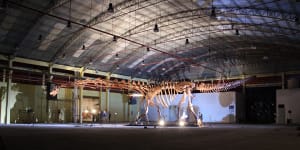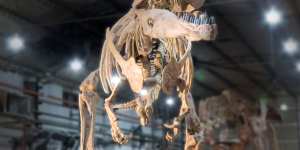Dinosaurs of Patagonia features 13 dinosaur species from the southern region of South America,an area rich with fossils from across the age of dinosaurs.

The Patagotitan skeleton being assembled at the Queensland Museum.Museo Paleontológico Egidio Feruglio
The star attraction is a reproduction of the skeleton ofPatagotitan mayorum,a massive sauropod weighing about 70 tonnes and measuring 38 metres in length.
Queensland Museum palaeontologist Dr Scott Hocknull,part of the local team putting the exhibition together,was also one of the lead scientists who discoveredin outback Queensland in 2021.
He had to concedePatagotitan was slightly bigger thanAustralotitan – but not by much.
“The fossils that we have at this stage are more fragmentary and not as well preserved,but the pieces we do have are close to being the size ofPatagotitan,” Hocknull said.
“We’re talking a 10-to-20 centimetre difference in size between the Australian fossils and the South American ones,so there’s not much in it.”
Patagotitan lived 100 million years ago during the Cretaceous Period,around the timeAustralotitan boomed across the plains of ancient Australia.
At the time,Australian and South America were connected to either side of Antarctica in a super-continent called Gondwanaland.
Hocknull said rather than being the same species,the two giants probably shared a common ancestor and then became gigantic because of similar evolutionary pressures.
Australia probably had a similar range of dinosaur species as South America,he said,but while South America had the Andes mountains to push fossils to the surface,Australia’s fossils mostly remain buried deep underground.

The predator Tyrannotitan lived at the same time as Patagotitan,and may have had a counterpart in Australia.Museo Paleontológico Egidio Feruglio
Another highlight of the exhibition is the large predatorTyrannotitan,12 metres long,with its large knife-like teeth.
Hocknull said Australia probably had its own version ofTyrannotitan,but it hadn’t been found yet.
“You can’t have gigantic herbivores without something to eat them – that’s the case across the world,for dinosaurs right up to mammals,” he said.
Despite the grandeur of the giant dinosaurs,the fossils on display run the gamut from the largest,down toGasparinosaura at just 0.4 metres long,and stretches far back in time to animals such asEoraptor,which was one of the earliest dinosaurs,living in the Triassic period 230 million years ago.
Hocknull said his secret favourite was theCarnotaurus,mostly because,with its miniscule arms,smaller than a T-Rex’s,and squat head with two horns that give it its name,it was “so weird”.
“The dinosaurs of the southern hemisphere were a weird breed;there’s absolutely nothing from the northern hemisphere that comes close to the weirdness of these dinosaurs,” he said.
“This exhibition is a once-in-a-lifetime opportunity to see these specimens in person.”
The exhibition was curated by palaeontologists from the Museo Paleontológico Egidio Feruglio in Argentina,and runs at the Queensland Museum from March 17 to October 22.